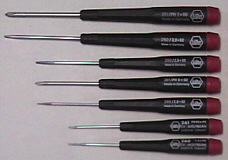Drivers
 You will need a set of
Jeweler's screwdrivers. There are several brands on the market.
Shown at the left are tools made by Wiha that have hardened tips and are
excellent quality. You will need a set of
Jeweler's screwdrivers. There are several brands on the market.
Shown at the left are tools made by Wiha that have hardened tips and are
excellent quality.
The most common jeweler's screwdrivers are more economical and are sold by
Wal-Mart, Radio Shack and a variety of other places. These are the ones
that have black blades, chromed handles and come in the blue plastic box with
the clear cover. These are the only type I was aware of when I first got
into model-building and probably the only ones available.
They work but the tips are brittle and will break easily
if dropped or too much force is applied. In other words, do not use them as
chisels or pry bars. The other problem with them is that the tips are too
thin. They are made for watch-makers and others who use micro-hardware
— stuff smaller than we normally use.
There are better drivers available — the Wiha drivers
shown are excellent but there are other brands that will work as just as well.
You will need a
couple flat blades as well as Phillips tips. In addition to these you will
need a set of small Allen hex keys for various Allen head bolts. Not strictly
necessary but nice to have are Allen drivers. They will not fully replace
the keys but they are easier to use and get the job done faster.
 Ball head drivers are good for hard to reach areas but they shouldn't be used
for significant torque loads. Use a straight driver or a hex key instead
to tighten down the hardware after it is driven. Ball head drivers are good for hard to reach areas but they shouldn't be used
for significant torque loads. Use a straight driver or a hex key instead
to tighten down the hardware after it is driven.
Do not buy the cheap tool steel ball drivers through the hobby manufacturers.
The ball makes very little contact inside the head of a hex driver. Buy hardened ball drivers. The two brands that I know of that I would not even consider purchasing are by Dubro
and Great Planes. These tools are so soft they will round over quickly and
give you fits.
If you work with Japanese items then it is worth it to purchase a set of
Japanese Industrial Standard (JIS) screwdrivers. These look like Phillips drivers
but I'm told they aren't the same thing. At first I was skeptical
thinking someone was just trying to make another sale. However, I found
that the JIS drivers fit better into the screws on my Japanese engines and on my
helicopter. In fact, they are a near perfect fit and I am no longer
experiencing stripped out Phillips heads (which were not Phillips heads at all I
guess).
Which brings me to my next point. A lot of people have problems with
Phillips screw heads getting chewed up — I know I did. It took me a while,
but I finally learned that using the largest Phillips driver that fits
the screw will prevent most of these problems. It also helps to use
quality hardware rather than some of the soft junk hardware that comes with some
kits, ARF's and other accessories.
By the way, you've probably come across a tip or
two about magnetizing your screwdrivers. I used to do that but found that
it became really aggravating in the long run. The screwdrivers were constantly
attracting things that I did not want stuck to them as well as small metal
shavings etc. The time I spent cleaning metallic crud from my screwdrivers
negated any benefit of it being magnetized.
I decided that it was easier to use a tweezer to put a screw
in a hard to reach location than forever deal with a tool that had things stuck
all over it — and I use the same screwdrivers around my computers
where magnets are bad news.
While on the subject of magnets, I also used to
use one to pick up spilled hardware, T-pins, etc. I don't do that any more
for the exact same reason. OK, back to the subject of the page...
|
![]()